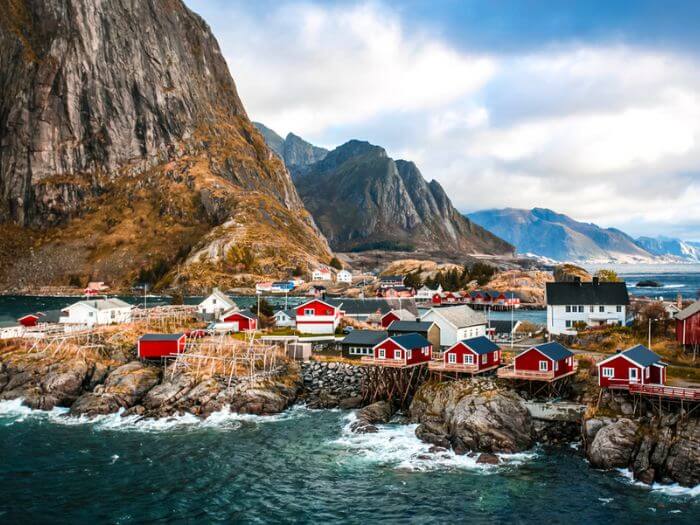Learning Norwegian? At some point, preferably sooner rather than later, you'll have to tackle Norwegian verb conjugation.
Verb conjugation inevitably conjures the ghost of stuffy classrooms, teachers with flat voices reciting abstract rules nobody understands and endless lists of words you think you’ll never remember.
Yet Norwegian verb conjugation is essential for clear communication in Norwegian. That's why I've written a whole post about it!
While in some ways Norwegian verb conjugation is simple, you should also be aware that the Norwegian language has a few surprises in store. Let's see what those are!
Pro Tip
By the way, if you want to learn Norwegian fast and have fun, my top recommendation is Norwegian Uncovered which teaches you through StoryLearning®.
With Norwegian Uncovered you’ll use my unique StoryLearning® method to learn Norwegian through story…not rules. It’s as fun as it is effective. If you’re ready to get started, click here for a 7-day FREE trial.
Table of Contents
Norwegian Verb Conjugation: What Is It & Good News

Verb conjugation is the way a verb changes when you alter something like time or amount in a sentence.
When it comes to Norwegian verb conjugation, you'll notice with relief that you don’t have to inflect (change) a verb when you change pronoun (I, You, He/She/It etc.).
This means, while in other languages, including English, you have to rattle off I am – You are – He/She/It is etc., Norwegian verbs will always keep the same spelling, never mind what pronoun you use.
More good news: the Norwegian future is easy to conjugate. Just use vil (will) or skal (shall) before the infinitive, like in English!
- I will learn Norwegian – Jeg vil lære (meg) norsk
Bear in mind though that skal is more common in everyday, spoken Norwegian. When in doubt, use skal!
While Norwegian verbs don't change according to person, Norwegian verb conjugation does change according to tense. And that's not all.
How Many Different Verb Groups Are There In Norwegian?

When you search for Norwegian verb conjugation online, you most often find a differentiation of only two groups: weak verbs and strong verbs.
This might give you an immediate relief. Only two groups to consider when conjugating? Learning Norwegian verbs can’t be all that bad then!
Unfortunately, it’s a trap to make you feel safe and to avoid complicated explanations. Dividing verbs into weak and strong won't help you to conjugate, quite simply because you'll only know which group your word falls into AFTER you have conjugated it.
Weak Norwegian verbs, also known as regular verbs, end in -er in the present tense and –et, -te, -de and –dde in the past and present perfect.
Strong – or irregular – verbs change their vowels when they move around different tenses.
So how do you know when to use –et or –te or –de or –dde? And which vowel within a Norwegian verb will be changed in what way?
This is where the complicated sounding, but easily to apply grouping of four different regular verb-types comes in. By taking a look at the root, also called stem, of a word, it will tell you how you have to conjugate it.
Here I’ll give you the rundown of the four main groups regular verbs fall into and explain, how best to remember which one is which.
When you look at the following list, please remember that in Norwegian apart from a, e, i, o and u also the additional letters æ, ø and å as well the y count as vowels. For more on this, take a look at my post on Norwegian pronunciation.
Conjugating Norwegian Verbs Ending In Two Consonants

This is the biggest group of Norwegian verbs and the one you will meet the most when you start reading and writing Norwegian.
Verbs within this group are also fairly easy to spot. Their root, which I have marked here in bold, will end in two consonants (though there are some exceptions).
Their conjugation is also easy to apply, because the ending of the word will not change from the past to present perfect.
Here are few common examples of Norwegian verbs within this group.
| Infinitive | Present | Past | Present perfect |
| å elske (to love) | jeg elsker (I love) | jeg elsket (I loved) | jeg har elsket (I have loved) |
| å jobbe (to work) | du jobber (you work) | du jobbet (you worked) | du har jobbet (you have worked) |
| å lytte (to listen) | han lytter (he listens) | han lyttet (he listened) | han har lyttet (he has listened) |
As a hint, Norwegian children in school will be told that this is called the snakkegruppe (the Talking Group) because it includes the Norwegian verb for “to talk”:
å snakke (to talk) – vi snakker (we talk) – vi snakket (we talked) – vi har snakket (we have talked)
Conjugating Norwegian Verbs Ending In A Single Consonant
Group 2 also includes a wide range of commonly used verbs.
Here the verb has a single consonant at the end of the root and when you move from the past to the present perfect tense, the last letters change from –te to a single -t.
| Infinitive | Present | Past | Present perfect |
| å bruke (to use) | jeg bruker (I use) | jeg brukte (I used) | jeg har brukt (I have used) |
| å høre (to hear) | du hører (you hear) | du hørte (you heard) | du har hørt (you have heard) |
| å leke (to play) | hun leker (she plays) | hun lekte (she played) | hun har lekt (she has played) |
Again, Norwegians give themselves a hint for this group and generally call it lesegruppen (the Reading Group) with reference to
å lese (to read) – dere leser (you read) – dere leste (you read) – dere har lest (you have read)
which belongs to group 2.
Conjugating Norwegian Verbs Ending In V, G, Ei, Ai, Øy, Au & Eu
In group 3, things get a bit exotic and more confusing, mainly because it includes diphthongs (a combination of two vowel sounds) and letter combinations you're not used to.
It’s also a bit more difficult to distinguish, particularly because some of the words seemingly look like the verbs in group 2.
However, when the root of a verb ends in v, g, ei, ai, øy, au and eu, it will belong to this group and be inflected with –de and -d.
| Infinitive | Present | Past | Present perfect |
| å leve (to live) | jeg lever (I live) | jeg levde (I lived) | jeg har levd (I have lived) |
| å lage (to make) | du lager (you make) | du lagde (you made) | du har lagd (you have made) |
| å dreie (to turn) | det dreier (it turns) | det dreide (it turned) | det har dreid (it has turned) |
| å drøye (to linger) | de drøyer (they linger) | de drøyde (they lingered) | de har drøyd (they have lingered) |
And yes, here also lies a clue in what Norwegians call the group: prøvegruppen (the Trying Group) as in:
å prøve (to try) – vi prøver (we try) – vi prøvde (we tried) – vi har prøvd (we have tried)
Conjugating Norwegian Verbs Ending In A Strongly Pronounced Vowel
Group 4 verbs are the easiest to spot as they are short, compact and always have a root ending in a strongly pronounced vowel.
Remember: a vowel apart from the usual suspects includes y as well as æ, ø and å. In the past tense, they will end in –dde while the present perfect becomes –dd.
| Infinitive | Present | Past | Present perfect |
| å bety (to mean) | jeg betyr (I mean) | jeg betydde (I meant) | jeg har betydd (I have meant) |
| å klå (to scratch) | du klår (you scratch) | du klådde (you scratched) | du har klådd (you have scratched) |
| å skje (to happen) | det skjer (it happens) | det skjedde (it happened) – | det har skjedd (it has happened) |
| å tro (to believe) | dere tror (you believe) | dere trodde (you believed) | dere har trodd (you have believed) |
The group is universally known as the bogruppe (the Living-Group) with reference to:
å bo (to live as in stay at) – vi bor (we live) – vi bodde (we lived) – vi har bodd (we have lived)
Be careful though with this group as quite a few irregular verbs seemingly look like they belong here, but don’t.
Norwegian Verb Conjugation: Exceptions

Now you probably sit down and learn the verbs, conjugating them exactly according to the instructions – until you come over, among other, å prate (to chat) in group 1.
å prate (to chat) – jeg prater (I chat) – jeg pratet (I chatted) – jeg har pratet (I have chatted)
and no matter how long you stare at the word, the root still only ends on one consonant (t) and strictly speaking should belong to group 2.
Yet here it is, in group 1 – and there is nothing you can do about it if you want to speak Norwegian correctly.
Yet the reason for the apparent ‘wrongful’ placement is simple. The word would just sound odd, if not awful, if you placed it in the second group.
Once you’ve done a few weeks of Norwegian and have an ear for the language, you will know what I mean.
Also in group 2, you will inevitably come across the word
å glemme (to forget) – jeg glemmer (I forget) – jeg glemte (I forgot) – jeg har glemt (I have forgotten)
and you will scratch your head and wonder, if the consonant M is something different in Norwegian, especially since also other verbs with double Ms like å bestemme (to decide), å gjemme (to hide) and å svømme (to swim) are in group 2.
Here the reason is also simple.
Through inflection, the second M gets lost, reducing the stem or root of the word to glem/bestem/gjem/svøm – ending in one consonant and therefore belonging to group 2.
In other cases, the explanations will not be so simple. Norwegian Bokmål still is a relatively new language and constantly in development.
Sometimes verbs – or any word – might have changed their spelling throughout the years, but not their inflection and so remain in the same conjugation group.
What About Norwegian Irregular Verbs?

Reading all of the above, you might think that the Norwegian regular verbs already are highly ‘irregular’.
Yet there is still more to come, for Norwegians also have quite a few (approximately 150) true irregular verbs on offer.
Here are the four most common you'll meet right at the beginning:
| Infinitive | Present | Past | Present perfect |
| å få (to get) | jeg får (I get) | jeg fikk (I got) | jeg har fått (I have got) |
| å gå (to go) | du går (you go) | du gikk (you went) | du har gått (you have gone) |
| å ha (to have) | hun har (she has) | hun hadde (she had) | hun har hatt (she has had) |
| å være (to be) | de er (they are) | de var (they were) | de har vært (they have been) |
My best advice to cope with the mindboggling number of exceptions in the verb group as well as the irregular verbs is to make yourself some easy to remember mental markers like:
- å prate (to chat): belongs to snakkegruppe 1 (talkative group) like most other verbs connected to verbal actions, including å klage (to complain), å erte (to tease) or å krangle (to argue) or
- å eie (to own) has some unfamiliar letter combinations and should go into prøvegruppen because it's the only group which has an unfamiliar letter in its name.
This obviously requires, that you learn the colloquial Norwegian names for the groups right from the start:
- Group 1: Snakkegruppen (The Talking Group ending on two consonants) – å snakke
- Group 2: Lesegruppen (The Reading Group ending on one consonant) – å lese
- Group 3: Prøvegruppen (The Trying Group ending on v, g or diphthongs) – å prøve
- Group 4: Bogruppen (The Living Group ending on a strongly pronounced vowel) – å bo
A comprehensive list of the most commonly used Norwegian verbs in their respective groups, including some of the exceptions, can be found on the website for foreign language speakers in Norway Norskfordeg.no.
Else you can follow the 6 Tips below to get a grip on Norwegian verb conjugation.
6 Tips to Get You Going on Norwegian Verb Conjugation

Four groups, strange letters, wildly differing forms of conjugation from one Norwegian verb group to the next and then all those exceptions might seem a lot to take onboard when you first start out to learn the language.
Believe me, it’s far easier than it sounds. Here I’ve collected some tips on how to get your head around the seemingly complicated Norwegian verb conjugation rules and how to remember them
1. Start Short But Sweet By Building Your Own Norwegian Sentences
Norwegian is a very forgiving language with regards to sentence length. Unlike other Germanic languages, like for example German, it will never sound odd if you stick to lining up short sentences with as few commas as possible.
In fact, unless you are the Norwegian Nobel Prize Winner for Literature Jon Fosse, you should avoid using commas at all when you first start out to learn Norwegian.
By using as few building blocks for a sentence as possible, you have the opportunity to focus on every single word instead of having to bother about sentence structures as well.
All you need is a subject, a verb, an adjective and an object, never mind what tense you write in:
- Jeg (Subject) elsker (verb) røde (adjective) epler (object) – I love red apples
Now move the same sentence into the past:
- Jeg (Subject) elsket (verb) røde (adjective) epler (object) – I loved red apples
Or
- Jeg (Subject) har elsket (verb) røde (adjective) epler (object) – I have loved red apples.
Begin with the verbs in the first group, which contains the most commonly used verbs in Norwegian, then move your way downwards through the rest of the groups.
2. Read Simple Norwegian Texts

Reading Norwegian is quite obviously the most entertaining and fun way to learn the language.
It's also the best training you can possibly get to pick up vocabulary, Norwegian grammar and Norwegian verb conjugation.
But before you rush out and order your favourite Nordic Noir or Norwegian explorer books, you should be aware that your ambitions can backfire, especially when you are only at the beginning of your language learning journey.
When you pick books or texts that are far above your comprehension level and you don’t even know half of the words they contain, you'll get discouraged and might lose interest in both books and the language.
If you, however, follow the rules of StoryLearning and read at your level, you can reach a far more rewarding result.
You can take a look at my collection of 8 Short Stories in Norwegian for Beginners, with texts for adult readers that will ease you into the world of the Norwegian vocabulary and conjugations.
Instead of staring at tables and trying to memorise the verbs, you will find them in their ‘natural habitat’ within properly constructed sentences you easily can understand.
Once you’ve read my Short Stories in Norwegian and still want more, I have compiled a list of books in Norwegian that should satisfy every eager bookworm with an adventurous mind.
When you’re through with this reading list, I promise you that you know Norwegian verb conjugation without even having to think about groups anymore.
3. Think English When Learning Norwegian

Yes, I know how odd it sounds. Yet in terms of grammar, English and Norwegian have actually more things in common than differences.
It doesn't matter if you are a native English language speaker or have learned English as a second language.
Since you are here reading this blog post, I have to assume you are proficient in English anyhow – which will greatly help you to conjugate Norwegian verbs.
Especially at the beginning when you're still grappling with the new vocabulary and the grammar, not to speak of all the exceptions, an ‘English attitude’ will be helpful.
That's because you only have to learn a few words in addition to your verb which also resemble their English counterparts like ha (have).
- I have moved next door – Jeg har flyttet til nabohuset
As you can see, Norwegian sentence structure follows English pretty much word for word. All you have to do is focus on what group your verb falls into. The rest will come naturally.
4. Train Your Ears By Listening To Norwegian Podcasts

Reading and writing Norwegian is one thing. Hearing it spoken by a local is quite another. Listening to Norwegian podcasts will make the language come alive and lift it out of the abstract, theoretical stage.
As Norwegians are very proud of their culture and language, there are quite a few available online.
Two of the best ones for beginners are Norwegian Class 101 and Practice Norwegian a sadly discontinued podcast.
By listening to podcasts, you will get an impression of how verb conjugation works in practice in a natural Norwegian environment.
You might not always get an explanation for why one verb is conjugated differently from another, but rather hear how it sounds in context.
Listening to podcasts will help you to understand how the theoretical approach of placing the verbs into different groups is actually used in real life.
5. Do It Wrong To Get It Right

If you're lucky enough to have a Norwegian to practise your Norwegian verb conjugation on, then you should grab the opportunity as often as you possibly can – without necessarily thinking about the groups.
Just talk away and during a conversation you'll inevitably get one or more of the verbs wrong.
While Norwegians will be very forgiving in ignoring the occasional wrong prepositions or misplaced articles in a sentence, they will never pass on a wrongly conjugated Norwegian verb.
They can’t help it. A verb with a wrongly applied inflection will sound jarring and the correction will be the result of a natural reflex rather than impatience or arrogance.
If you stand corrected once – you will rarely or never make the same mistake again. Forget about the four groups for a moment, for there’s no better way to learn Norwegian conjugation than doing it wrong in front of a Norwegian.
6. When All Else Fails – Cheat

Writing in Norwegian is fun. There's an excitement to using a set of completely new letters.
And as the sentences don’t sound boring if you keep them short, you will very quickly think of yourself as quite proficient after beginning to learn the language.
Yet while you happily write along, you'll inevitably get stuck. There is always the odd, but necessary Norwegian verb you simply can’t allocate its conjugation group.
Getting stuck usually takes the fun out of writing, and that’s why I suggest – you should cheat!
There's an array of conjugation aids for Norwegian available online. The best – and most reliable – one I found to be Verbix.
All you have to do is to type in the Norwegian verb and within seconds it’ll give you all the different possible conjugations for that word.
Verbix even is kind enough to provide a cut-and-paste solution for all the letters (æ, ø and å) you don’t find on your keyboard.
FAQs About Norwegian Verb Conjugation
How to conjugate verbs in Norwegian?
Conjugating verbs in Norwegian is relatively straightforward compared to many other languages, as verbs don't change based on the subject (there's no “he goes” vs. “they go” distinction).
Instead, they only change according to tense. Here's an overview of how to conjugate verbs in Norwegian in the present, past, future, and conditional tenses, as well as in the infinitive form.
1. Present Tense (Presens)
For most verbs, the present tense is formed by adding -r to the infinitive form.
Infinitive: å spise (to eat)
Present: Jeg spiser (I eat)
2. Past Tense (Preteritum)
Norwegian verbs are typically divided into regular and irregular verbs. Regular verbs follow certain patterns, while irregular verbs have their own unique forms.
Regular Verbs
Group 1 Verbs: Verbs that end in -et in the past tense.
Infinitive: å snakke (to speak)
Past: Jeg snakket (I spoke)
Group 2 Verbs: Verbs that end in -te in the past tense.
Infinitive: å kjøpe (to buy)
Past: Jeg kjøpte (I bought)
Irregular Verbs
These verbs do not follow a specific pattern.
Infinitive: å være (to be)
Past: Jeg var (I was)
3. Future Tense (Futurum)
There are two main ways to form the future tense:
Using skal + infinitive:
Jeg skal spise (I will eat)
Using vil + infinitive:
Jeg vil gå (I will go)
4. Conditional (Kondisjonalis)
To form the conditional tense, you generally use ville (would) + infinitive.
Jeg ville spise (I would eat)
Han ville gå (He would go)
5. Infinitive
The infinitive form of verbs in Norwegian is usually preceded by the particle å.
å spise (to eat)
å snakke (to speak)
6. Perfect Tense (Perfektum)
The perfect tense is formed by using har (have) + past participle.
Jeg har spist (I have eaten)
Jeg har snakket (I have spoken)
7. Passive Voice
The passive voice in Norwegian is usually formed by adding -s to the verb.
Infinitive: å lese (to read)
Passive: Det leses (It is read)
How many verb tenses are in Norwegian?
In Norwegian, there are six main verb tenses used to express different times and aspects of actions. Here’s an overview of the six main tenses:
1. Present Tense (Presens)
Used to express actions happening now or general truths.
Example: Jeg snakker (I speak / I am speaking)
2. Past Tense (Preteritum)
Describes actions that happened in the past and are completed.
Example: Jeg snakket (I spoke)
3. Future Tense (Futurum)
Describes actions that will happen in the future. Formed using skal or vil + infinitive.
Example: Jeg skal snakke (I will speak)
4. Perfect Tense (Perfektum)
Describes actions that have been completed before the present moment. Formed with har (have) + past participle.
Example: Jeg har snakket (I have spoken)
5. Past Perfect Tense (Pluskvamperfektum)
Describes actions that were completed before a certain point in the past. Formed with hadde (had) + past participle.
Example: Jeg hadde snakket (I had spoken)
6. Conditional Tense (Kondisjonalis)
Used to describe hypothetical or possible actions, often with ville (would) + infinitive.
Example: Jeg ville snakke (I would speak)
What is the order of verbs in Norwegian?
In Norwegian, the order of verbs in sentences follows some specific patterns, and word order generally adheres to subject-verb-object (SVO) structure in main clauses.
However, Norwegian uses the V2 rule in many cases, meaning the verb must always come second in declarative sentences. If the sentence starts with an adverb or other element, the verb still comes second, and the subject follows the verb.
Example: I dag spiser jeg mat (Today I eat food)
Adverb (I dag) + Verb (spiser) + Subject (jeg) + Object (mat)
What are the classes of verbs in Norwegian?
Norwegian verbs are divided into different classes based on how they form their past tense and past participle.
The two main types are regular verbs (which follow predictable patterns) and irregular verbs (which do not).
Regular verbs are further divided into four classes based on the endings they take in the past tense and past participle.
1. Regular Verbs (Svake verb)
Regular verbs follow set patterns for forming the past tense. These are further divided into four main classes.
Class 1 Verbs
These verbs end in -et in the past tense. They are the most common type of verb in Norwegian.
Infinitive: å snakke (to speak)
Present: snakker
Past: snakket
Past Participle: har snakket
Examples:
å danse (to dance) → danset (danced)
å jobbe (to work) → jobbet (worked)
Class 2 Verbs
These verbs end in -te in the past tense and typically have infinitives ending in consonants (often “-p”, “-k”, “-g”, “-f”, “-v”).
Infinitive: å kjøpe (to buy)
Present: kjøper
Past: kjøpte
Past Participle: har kjøpt
Examples:
å lese (to read) → leste (read)
å hjelpe (to help) → hjalp (helped)
Class 3 Verbs
These verbs have a short vowel in the stem and form their past tense by adding -dde.
Infinitive: å bo (to live)
Present: bor
Past: bodde
Past Participle: har bodd
Examples:
å tro (to believe) → trodde (believed)
å kle (to dress) → kledde (dressed)
Class 4 Verbs
These verbs end in -de or -dde in the past tense and usually end in a stressed vowel in the infinitive.
Infinitive: å bety (to mean)
Present: betyr
Past: betød
Past Participle: har betydd
Examples:
å fly (to fly) → fløy (flew)
å nå (to reach) → nådde (reached)
2. Irregular Verbs (Sterke verb)
Irregular verbs, or strong verbs, don't follow regular patterns for their past tense and past participle forms. These verbs often undergo a vowel change in the stem.
Infinitive: å gå (to go)
Present: går
Past: gikk
Past Participle: har gått
Examples of irregular verbs:
å være (to be) → var (was)
å få (to get) → fikk (got)
å gjøre (to do) → gjorde (did)
Now Jump Right Into Norwegian Verb Conjugation
When you look at the rules for Norwegian conjugation and the grouping of regular verbs and irregular verbs, you might feel a bit overwhelmed.
However, this should only give you a framework for Norwegian grammar and how it works.
Don’t start memorising words in the regular and irregular tables just to feel like you're learning Norwegian.
Language learning doesn't work like that. And as long as you don’t have anything to put the verbs into relation to, you will soon have forgotten most of what you painstakingly have tried to confine to memory.
Instead, you could sign up to my course, Norwegian Uncovered to learn how Norwegian verb conjugation works in real life and within real sentences or read Short Stories in Norwegian to practice what you’ve learned.

Olly Richards
Creator of the StoryLearning® Method
Olly Richards is a renowned polyglot and language learning expert with over 15 years of experience teaching millions through his innovative StoryLearning® method. He is the creator of StoryLearning, one of the world's largest language learning blogs with 500,000+ monthly readers.
Olly has authored 30+ language learning books and courses, including the bestselling "Short Stories" series published by Teach Yourself.
When not developing new teaching methods, Richards practices what he preaches—he speaks 8 languages fluently and continues learning new ones through his own methodology.










































